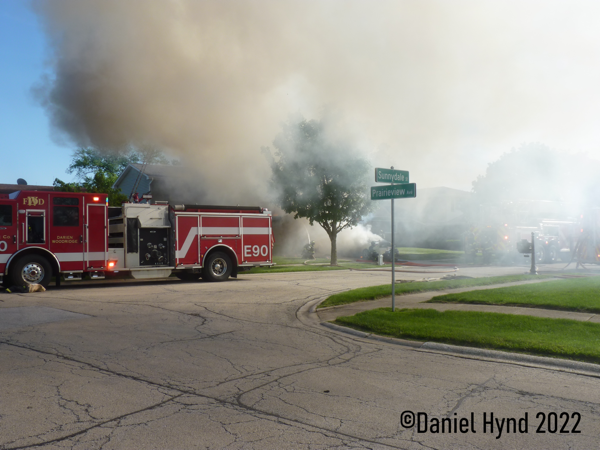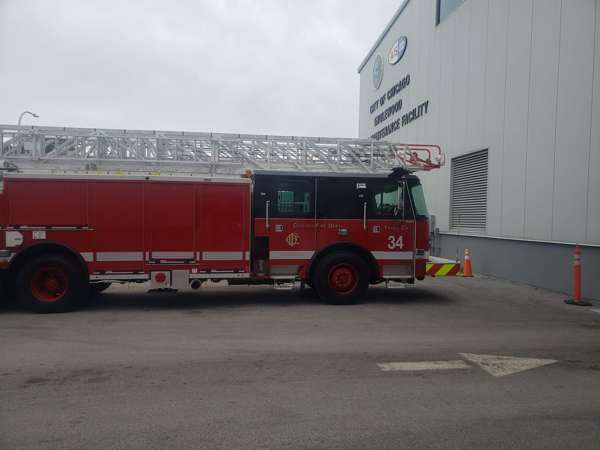This from Daniel Hynd:
Darien-Woodridge FPD and surrounding departments responded to a fire in an attached garage in the 2100 block of Sunnydale St in Woodridge on the evening of 5-30-22.

Daniel Hynd photo

Daniel Hynd photo
May 30
Posted by Admin in Apparatus on-scene, Fire Department News, Fire Scene photos | Comments off
This from Daniel Hynd:
Darien-Woodridge FPD and surrounding departments responded to a fire in an attached garage in the 2100 block of Sunnydale St in Woodridge on the evening of 5-30-22.

Daniel Hynd photo

Daniel Hynd photo
Tags: chicagoareafire.com, Daniel Hynd, Darien-Woodridge FPD, Darien-Woodridge FPD Engine 90, Darien-Woodridge FPD Medic 89, Downers Grove FD Engine 105, Downers Grove FD Tower 102, Ferrara, Ferrara fire engine on scene, fire scene photos, house fire in Woodridge IL, Lisle Woodridge FPD Engine 52, Lisle-Woodridge FPD Battalion 51, Tri-State FPD Ladder 122
May 30
Posted by Admin in Fire Department News, Fire Truck photos, New Delivery | 15 Comments
Found on Facebook:
New truck 34
Shop # E-372

Found on Facebook

Found on Facebook
thanks Danny
Tags: Chicago FD Truck 34, Chicago Fire Department, chicagoareafire.com, new truck for Chicago
May 30
Posted by Admin in Fire Department History | 4 Comments
From Phil Stenholm:
Another installment about the History of the Evanston Fire Department
HAPPY BIRTHDAY!
On May 1, 1975, the Evanston City Council accepted bids for a new 1,000 / 300 triple-combination pumper, with the exact same specifications as the two Howe pumpers purchased a year earlier. The new pumper would replace the 1952 Pirsch 1000 / 100 TCP (Engine 25) that was originally Squad 21 before being rebuilt as a TCP by General Body in 1966. Mack came in with the low bid of $53,725, beating out FWD Seagrave, Pirsch, and several other apparatus manufacturers for the contract. As expected, EFD Chief George Beattie specified that the new Mack pumper be painted “safety yellow,” just like the two Howe pumpers delivered in 1974 and 1975.
In addition, Chief Beattie received a new Plymouth sedan (fleet # 301) in 1975 that was painted red instead of “safety yellow,” with the chief’s 1973 Plymouth station wagon transferred to the platoon commanders as the new F-2 after a light bar was installed on the roof replacing the portable “Kojak light.” The former F-2 (1971 Dodge station wagon) was transferred to the Fire Prevention Bureau (FPB) to be used by the newly-created fire investigation unit (“arson squad”) that would be staffed each shift by a trained fire investigator. Firefighters Bob Schwarz, Pat Lynn, and Jim Hayes were appointed fire investigators by Chief Beattie. As part of the reorganization, one of the two FPB captain positions was eliminated after Capt. Joe Thill retired.
Also, as part of the contract resulting from the firefighters strike of February 1974, the average work-week for firefighters was reduced from 56 hours to 54 hours, with two new positions created in the EFD in 1975 that increased total membership from 100 to 102. One fireman would now be assigned each shift to cover for a fireman absent while on a “short day” (formerly known as a “Kelly Day”), with three firemen on each shift covering for vacations and sick leave. As a result, the de facto EFD minimum shift staffing was reduced from 28 to 27, with six three-man companies (the five engine companies plus Truck 22), two four-man companies (Truck 21 and Squad 21), and the shift commander (F-2).
Eighteen new firefighters were hired in 1974-75, including Samuel Boddie, Art Miller, Bill Betke, Jim Potts, Dave Lopina, Bob Hayden, Mike Adam, Don Gschwind, Thomas Simpson, Joe Hayes, Bob Wagner, Keith Filipowski, Ken Dohm, Tom Kavanagh, Milton Dunbar, Ward Cook, Jim Keaty, and Donald Williams. Also, Fireman James “Guv” Whalen was promoted to captain, firemen Harry Harloff and Ken Perysian retired after 23 years of service, and several other firefighters resigned.
On Wednesday, May 28, 1975, the Evanston Fire Department responded to a report of a fire in the rear storage yard of the Rust-Oleum Corporation at 2301 Oakton Street. A second alarm was struck immediately upon arrival of the first companies, and a MABAS box was eventually pulled, the first time the EFD had requested a MABAS box since the system was implemented in 1968.
At the peak of the fire, 19 2-1/2-inch hand lines, two deluge nozzles, one multi-versal, one ladder pipe from Truck 22, one street jack, and one deck gun from Squad 21 supplied streams that were played onto the storage yard and nearby exposures, as numerous 55-gallon drums full of paint exploded and were sent hundreds of feet into the air. Evanston police temporarily evacuated some of the residences to the east and north.
A 200,000-gallon water storage tank located at the southwest corner of Cleveland & Hartrey was supplied by a 24-inch feeder main that extended south from Church Street. The storage tank fed a 1,000-GPM pump owned by Rust-Oleum and operated by their company fire brigade, as well as the standard ten-inch and twelve-inch residential mains in the neighborhood. Engines from the Evanston, Skokie, Wilmette, Morton Grove, and Winnetka fire departments pumped water from numerous hydrants located to the east and north of the fire, including one hydrant at the dead-end of Cleveland Street at the C&NW RR Mayfair Division tracks 1/4 mile north of Rust-Oleum.
The conflagration was eventually surrounded, drowned, contained, and extinguished, but not before causing $775,000 in damage, making it the fourth highest loss from a fire in Evanston’s history up until that point in time. Only the fires at the American Hospital Supply Corporation (October 1963), the Rolled Steel Corporation (January 1970), and Bramson’s clothing store (October 1971) cause greater damage. If nothing else, the Rust-Oleum fire was certainly the most spectacular fire in Evanston’s history!
The next day — May 29, 1975 — the Evanston Fire Department celebrated its centennial. Although May 29, 1875, was the date that the EFD was legally established by ordinance, the actual genesis of the village fire department was January 7, 1873, when the 60-man volunteer Pioneer Fire Company of Evanston was accepted for service by the village board.
The purpose of the fire department ordinance of May 29, 1875 was not to create a firefighting force. The Pioneer Fire Company — renamed “Pioneer Hose Co. No. 1” in December 1874 when the Holly High-Pressure Waterworks was placed into service — already existed, and had existed for more than two years. Rather, the real purpose of the ordinance was to legally describe the method by which additional volunteer fire companies could be organized and accepted for service with the village going forward, since by May 1875 the C. J. Gilbert Hose Company was already in the process of being organized, chartered, and trained.
Once the C. J. Gilbert Hose Company was ready to be accepted for service, the ordinance needed to describe the relationship between the two hose companies. They might be rivals, but they could not be competitors. They had to work together for a common purpose. Also, the ordinance legally installed the fire marshal as chief of the fire department, with the two hose companies plus any other companies that might eventually be organized and accepted for service officially and legally under the command and direction of the fire marshal.
Tags: C. J. GILBERT HOSE COMPANY, Chicago Fire Department history, chicagoareafire.com, Chicagoareafire.com/blog, Evanston FD Chief George Beattie, Evanston Fire Department history, History of Evanston Fire Department, Phil Stenholm, Pioneer Fire Company of Evanston, Pioneer Hose Co. No. 1, Rust-Oleum Corporation fire in 1975
You are currently browsing the archives for Monday, May 30th, 2022

For the finest department portraits and composites contact Tim Olk or Larry Shapiro.
Arclite theme by digitalnature | powered by WordPress